mobile View, to the German Version tap the flag


- Principality of Asturias
- Autonomous Region of Spain
- 8th to 13th century Kingdom of Asturias
- to 1833 nominal principality as a part of Castile-Leon
- own names:
– Spanish: Principado de Asturias
– Asturian: Principáu d'Asturies
• Flag
• Historical and other Flags
• Meaning/Origin of the Flag
• Coat of Arms
• Meaning/Origin of the Coat of Arms
• Map of the autonomous regions of Spain
• Map of the historical Kingdoms on the Iberian Peninsula
• Numbers and Facts
• History
• Origin of the Country's Name
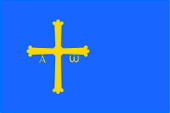
Flag of Asturias,
ratio = 2:3,
Source, by: Flags of the World






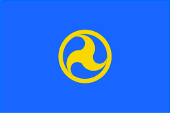
1976–1981, Conceyu Nacionalista Astur,
Flag of local nationalists,
ratio = 2:3,
Source, by: World Statesmen



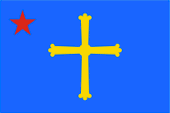
1982–1992, Ensame Nacionalista Astur,
Flag of leftist local nationalists,
ratio = 2:3,
Source, by: Wikipedia (ES)




The current flag of Asturias was introduced on 5th of October in 1981. It is monochrome light blue and shows a golden Christian cross, called the Victory Cross, shifted towards the flagpole. The Greek letters Alpha and Omega hang from its horizontal bar on the left and right. The appearance of the flag is regulated by the Statute of Autonomy of Asturias of 1981, renamed in 1999 the Statute of Autonomy of the Principality of Asturias, where the colours are only mentioned as blue and yellow. Likewise, Law 4/1990 of 19th of December in 1990 regulates the appearance of the flag and even names Pantone shades (yellow = Pantone 109, blue = Pantone 829), although a mistake may have been made. A Pantone 829 hue cannot be determined. The Victory Cross is a very old symbol, almost a relic. It was carried in front of the victorious Christian army during the battle of Covadonga against the Arabs in 722. In 908, the Asturian king Alfonso III (the Great) ordered that the original wooden cross made of oak be covered with gold and precious stones. Today it is kept in the Holy Chamber of Oviedo Cathedral. The origin of the present flag lies in a reconstruction from 1785. No heraldic symbols have survived from the early days of the country, which was absorbed into the Kingdom of Leon in the 11th century. One of the first mentions of land symbolism comes from Lazaro Díaz del Valle in the 17th century. However, he describes the golden Victory Cross on a red background. The light blue of the flag was probably taken from the coat of arms of the city of Oviedo, possibly because Asturias was called the "Kingdom of Oviedo" in the 8th and 9th centuries. The coat of arms of Oviedo shows a golden victory cross on a light blue background flanked by two angels. The colour blue represents the Virgin Mary. The letters alpha and omega refer to the Bible: "And he said unto me, It is done. I am the beginning and the end. I will give to the thirsty of the fountain of living water freely. He that overcometh shall inherit it all, and I will be his God, and he shall be my son." (Revelation 21:6-7). With the transfer of the capital to Leon and the unification of Galicia, Asturias and Leon into the Kingdom of Leon, it was probably not possible to develop a heraldry of their own. This was only revived with the emerging autonomy movement, reverting to the reconstruction of 1785. There is a variant of the flag of Asturias that shows the cross exactly in the centre of the flag cloth. It is to be used when the flag is not raised on a flagpole, but decoratively adorns a wall, table or lectern. There is a variant of the flag with the cross shifted towards the pole, which shows the cross set with precious stones, like the original of the cross in the Holy Chamber. This variant is intended as a ceremonial flag and for special occasions. Political and cultural groups that want to preserve and promote the identity of Asturias, or even want or desire the independence of the country, also use the light blue flag of Asturias, supplemented with their own symbolism, whereby the left-wing groups can be recognised by the red star. The "Conceyu Nacionalista Astur" showed a golden triskele in the centre. The triskele is a Nordic motif, possibly dating back to the Visigoths in Astruria. The triskele is a triangular knot that embodies the trinity of the Norse gods Wodan, Donar and Tyr (Odin, Thor and Ziu), but since christianisation it has also stood for the Holy Trinity.
Source: Wikipedia (ES),
Flags of the World,
1.) www.asturias.es,
2.) www.asturias.es,
Volker Preuß


since 1984,
Coat of arms of Asturias,
Source, by: upload.wikimedia.org

The current coat of arms of Asturias was last confirmed by law on 27th of April in 1984. The coat of arms is solid blue and shows a golden Christian cross with the Greek letters alpha and omega hanging from its horizontal bars on the left and right. It goes back to the coat of arms of the Provincial Council of Oviedo in 1857 and is similar to the coat of arms of the city of Oviedo. The Victory Cross is a very old symbol, almost a relic. It was carried in front of the victorious Christian army in 722 during the battle of Covadonga against the Arabs. In 908, the Asturian king Alfonso III (the Great) ordered that the original wooden cross made of oak be covered with gold and precious stones. Today it is kept in the Holy Chamber of Oviedo Cathedral. The origin of the present flag lies in a reconstruction from 1785. No heraldic symbols have survived from the early days of the country, which was absorbed into the Kingdom of Leon in the 11th century. One of the first mentions of land symbolism comes from Lazaro Díaz del Valle in the 17th century. However, he describes the golden Victory Cross on a red background. The light blue of the flag was probably taken from the coat of arms of the city of Oviedo, possibly because Asturias was called the "Kingdom of Oviedo" in the 8th and 9th centuries. The colour blue represents the Virgin Mary. The letters alpha and omega refer to the Bible: "And he said unto me, It is done. I am the beginning and the end. I will give to the thirsty of the fountain of living water freely. He that overcometh shall inherit it all, and I will be his God, and he shall be my son." (Revelation 21:6-7). Around the escutcheon a Latin saying, "HOC SIGNO TUETUR PIUS, HOC SIGNO VINCITUR INIMICUS," which translates as, "By this sign one is divinely protected, by this sign the enemy is defeated." The Spanish royal crown appears above the escutcheon.
Source: Wikipedia (ES),
Wikipedia (DE),
Volker Preuß

The autonomous Regions of Spain:
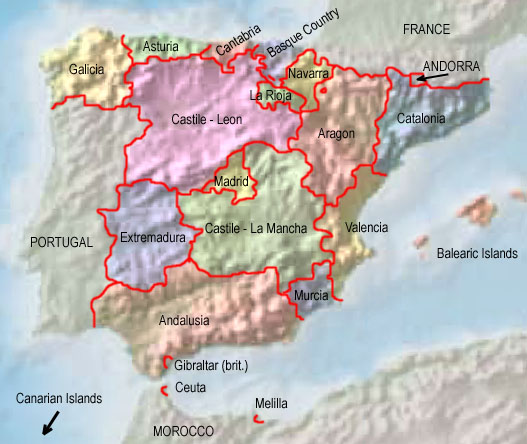
Source: Freeware, University of Texas Libraries, modyfied by: Volker Preuß

Map of the historical Kingdoms on the Iberian Peninsula:
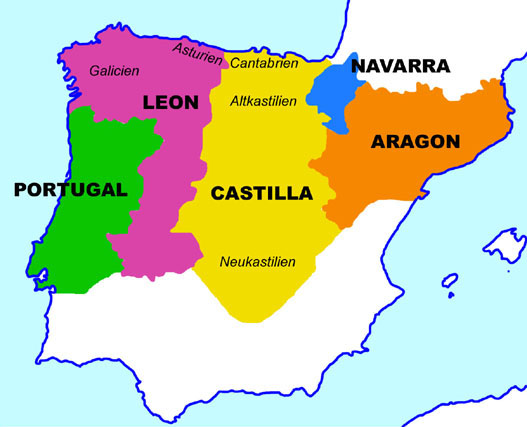
Map: Volker Preuß

Area: 4.093 square miles
Inhabitants: 1.004.686 (2022), mostly Asturians, also Galicians and Castilians
Density of Population: 245 inh./sq.mi.
Capital: Oviedo, 215.167 inh. (2022)
official Language: Spanish (Castilian)
other Languages: Asturian, Galician Eonaviego
Currency: Spanish (Euro) currency
Time Zone: GMT + 1 h
Source: Wikipedia (DE)

early age · settlement of the today's Cantabria by the Indo-European people of the Cantabrians (Latin: Cantabri)
ca. 600 B.C. · immigration of Celts and Iberians, evolution of the Celtiberians
218–201 B.C. · Second Punic War, the Roman Empire acquires the possessions of Carthago in Iberia, subjugation of whole Iberia until the year 19 B.C., Roman settlement, romanization, the today’s Asturia comes to the Roman province of Hispania Tarraconensis not until the year 22 B.C.
ca. 400 A.D. · Great Transmigration (Migration Period), immigration of Alans, Suebs and Western Goth, the today’s Asturia becomes a part of the Empire of the Western Goth
711–714 · annihilation of the Empire of the Western Goth by from northern Africa coming Arabs, the Western Goth retreat to Asturia and Cantabria, the Arabs are not successful in the conquest of Asturia
716 · duke Pelayo (Pelagius), escapes from the captivity of Wititsa – the against the Arabs loyal King of the Western Goth - from Toledo to Oviedo in Asturia
718 · the Western Goth elect Pelayo to their prince
722 · battle of Covadonga, Prince Pelayo of Oviedo beats the Arabs, start of the liberation war of the Iberian nations against the Arabs (Reconquista)
739–757 · reign of Alfons I., married with Hermesinde the daughter of Pelayo, since 753 king of Oviedo (Asturia)
856 · King Ordoño I. of Oviedo (Asturia) liberates Leon Town from the Muslims and occupies whole Galicia
910 · death of King Alfons III. of Oviedo, division of his empire under his sons, his son Garcia I. becomes King of Leon, his son Ordoño II. becomes King of Galicia, his son Fruela II. inherits Asturia
914 · death of King Garcia I., his brother King Ordoño II. of Galicia inherits Leon
914–924 · reign of King Ordoño II. of Galicia and Oviedo (Asturia)
924 · death of King Ordoño II., the heritage comes to King Fruela II. of Oviedo (Asturia), he transfers his residence from Oviedo to Leon, the country is named Kingdom of Leon from that point in time
931–950 · reign of King Ramiro II., a son of Ordoño II., unification of Galicia, Asturia and Leon under one crown (Kingdom of Leon), successful wars against the Arabs, expansion of the empire
1028–1037 · reign of King Bermudo III. of Leon
1037 · King Bermudo III. of León attacks the Kingdom of Castile, defeat and death of Bermudo in the battle near Rio Carrión, in this way vanish of the Pelayo dynasty, King Ferdinand of Castile inherits the Kingdom of Leon, in this way are Castile, León, Asturia and Galicia united under one crown (Kingdom of Castile-Leon).
1157 · death of King Alfons VII. of Castile, division of the heritage, Leon becomes an own kingdom again
1230 · Leon and Castile become united under one crown again by King Ferdinand III. of Castile, Kingdom of Castile-Leon, Asturia becomes a principality within Castile-Leon with many privileges
1388 · the crown princes of Castile-Leon (later also of Spain) adope the title "Prince of Asturia" an
1808–1813 · Asturia is occupied by French troops
1820 · abolition of the privileges
1823 · re-introduction of the privileges
1833 · the until that point in time in Spain existing partial kingdoms and regions become divided in provinces, the Kingdom of Asturia in the the provinces of Oviedo and Santander (Cantabria)
1936–1939 · Spanish civil war, Asturia struggles for a short time (1936) on the side of the socialistic central government
11th of January 1982 · Asturia gets the statute of autonomy within Spain (former province of Oviedo), establishment of the "Autonomous Community of Asturia"
1999 · the "Autonomous Community of Asturias" becomes renamed in "Autonomous Community of the Principality of Asturias"
Source: Wikipedia (ES),
World Statesmen,
RetroBib Retrobibliothek,
Volker Preuß

The name "Asturia" has its roots in the Roman administrative center "Asturica Augusta", a town nowadays is named Astorga and is situated in the today’s Castile-Leon. The Latin word "astura" means translated "small town". The inhabitants of the by "Asturica Augusta" administered areas were called by the Romans "asturco" – the today’s Asturians.
Source: unbekannt


![]()













